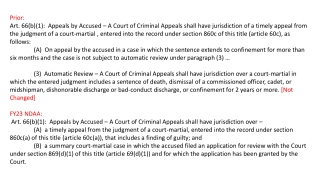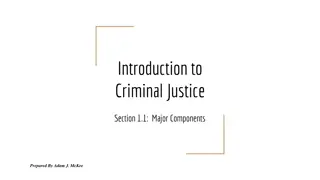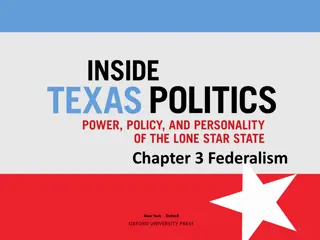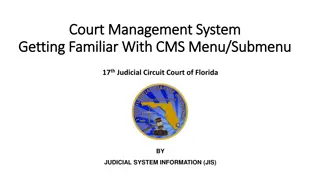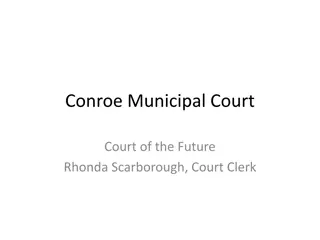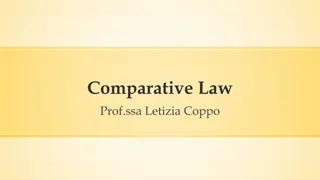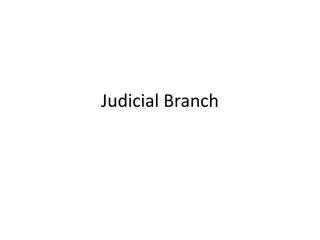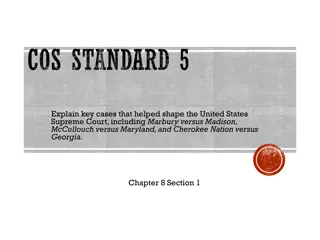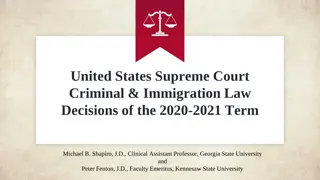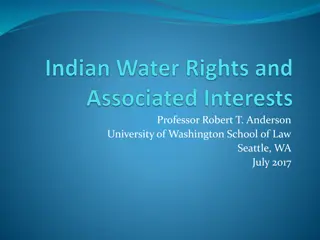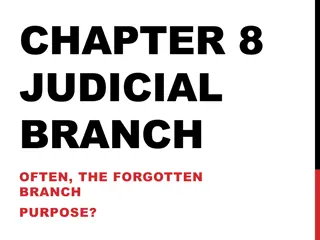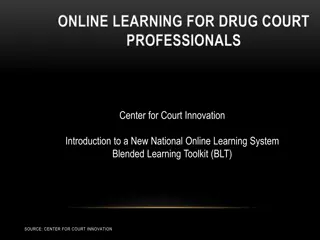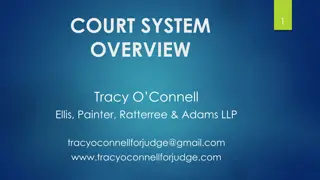Understanding the Federal Court System in the United States
The Federal Court system in the United States comprises District Courts, handling a vast number of cases each year, with each district having multiple judges. These courts have jurisdiction over a range of cases, including civil rights violations, employment disputes, criminal offenses, and bankruptcy matters. Court officials, such as judges and magistrate judges, play crucial roles in presiding over trials. Additionally, U.S. attorneys, public defenders, and U.S. Marshals Service ensure the proper functioning and security of the court system. The Federal Courts of Appeals serve as the intermediate layer, facilitating appeals from the District Courts. Despite the high volume of cases, successful appeals are relatively rare.
Download Presentation

Please find below an Image/Link to download the presentation.
The content on the website is provided AS IS for your information and personal use only. It may not be sold, licensed, or shared on other websites without obtaining consent from the author. Download presentation by click this link. If you encounter any issues during the download, it is possible that the publisher has removed the file from their server.
E N D
Presentation Transcript
Chapter 8: The Federal Courts and the Judicial Branch Section 2: Lower Federal Courts (pgs.227-232)
Federal District Courts http://www.lexadin.nl/wlg/pics/maps/usa.gif District Courts are the workhorses of the federal court system, handling over 300,000 cases a year. There are 94 federal court districts. Each has at least 2 judges. New York City is the largest with 44 judges.
Jurisdiction of District Courts Cases involving residents of different states and the U.S. and foreign governments. Civil offenses include violations of civil rights statutes & employment laws & make-up over 215,000 cases a year. Criminal offenses range from destruction of aircraft to making false statements during legal proceedings to murder and there are over 70,000 criminal cases a year. Criminal cases convene grand juries of 16 to 23 people to decide if criminal charges should be filed. Bankruptcy cases fall under federal jurisdiction. http://www.solano.courts.ca.gov/pubimages/2008-2009%20Grand%20Jury,3.jpg
Court Officials Judges are the primary official in any court and they preside over trials. The judge instructs juries about the matters of law they are to decide. In some cases the participants agree not to have a jury, in that case the judge decides the case. Bankruptcy judges are named by courts of appeals and serve for 14 years. District courts have magistrate judges that oversee early hearings and misdemeanor (minor criminal cases punishable by one year of less in prison) cases. These judges have 8 year terms. Each district court has a clerk of the court. They maintain records and the handling of money received in fines and fees. They also oversee jury recruitment. http://www.masc.sc/SiteCollectionImages/uptown/Anderson2.2.jpg
Other Courtroom Officials Each district has one U.S. attorney, he represents the U.S. government in federal court. When someone is charged with a crime the U.S. attorney or one of his/her assistants, acts as the prosecutor. The U.S. attorneys & their many assistants are employees of the Department of Justice and serve for a 4 year term. In criminal cases defendants who cannot afford are given public defenders. Each district is home to the U.S. Marshals Service. They provide security and police protection at federal courthouses, track down and arrest people accused of crimes, protect witnesses. http://www.theblaze.com/wp-content/uploads/2013/07/51708579.jpg
Federal Courts of Appeals This is the middle tier of the federal court system. Today there are 13 of these courts. The purpose of the Courts of Appeals is to hear appeals from the district courts. Each year these courts hear about 65,000 cases. In criminal cases the appeal will be filed by the guilty b/c the government cannot appeal a not guilty ruling. In civil cases either side can appeal. Regardless few appeals are successful. In 2009 less than 9% of filed cases were successfully appealed. http://thelexfirm.com/UserFiles/600px-US-CourtOfAppeals-Fed.png
Appeals Court Procedure The person who files an appeal is called the appellant & has to show that the original ruling was based on a legal mistake. Courts of appeals do not retry cases, they rely on the factual record as established by the trial court Most appeals are heard by a panel of 3 circuit judges. The appeals court reviews the trial court s written arguments called briefs and sometimes hears oral arguments. They reach a decision by looking at Supreme Court precedents and their own precedents but their rulings are not binding on other circuit courts. http://courtartist.com/wp-content/uploads/StemCell100927wide.jpg
After the Ruling The Court of appeals ruling is usually the final word on the case. In some cases the court might send a case back to the district court for additional hearings. A case may get further review from a larger panel of judges. This is called en banc review. A small number of cases go on to the Supreme Court. (This will be covered in section 3.) The Federal Circuit (1982) is a court of appeals that hears cases in international trade, government contracts, patents, & trademarks https://ecf.cafc.uscourts.gov/seal.gif
Other Federal Courts In addition to the district and circuit courts, Congress has created other Article III and Article I courts. These courts have limited jurisdiction to deal only with certain types of cases. U.S. Court of International Trade this court only deals with disputes in international trade. U.S. Tax Court these decisions can be appealed to the court of appeals. U.S. Court of Appeals for Veterans Claims hears disputes over veterans benefits, disability payments, or other veteran s matters. https://upload.wikimedia.org/wikipedia/commons/thumb/4/42/US-TaxCourt-Shield-BW.svg/2000px-US-TaxCourt-Shield-BW.svg.png
Other Federal Courts https://encrypted-tbn2.gstatic.com/images?q=tbn:ANd9GcQjbAu3E-QlFmm4PSWTgWY9dVvXXdtp1UJhSSjIgo5AVzDp0U1kFA U.S. Court of Federal Claims A nation has sovereign immunity so the U.S. has to agree to be sued. This court hears cases in which money claims are more than $10,000. These ruling can be appealed. U.S. Court of Appeals for the Armed Forces This court is for the military and hear appeals to courts-martial. The Foreign Intelligence Surveillance Court It s job is to review requests by the government to conduct spying operations on U.S. soil. Judges on this court are appointed by the Chief Justice for 7 years. Alien Terrorist Removal Court-- they can remove people from the U.S. Judges on this court are appointed by the Chief Justice for 5 years.
Other Federal Courts Military Commissions In the War on Terror the U.S. has captured enemy combatants. President Bush created these courts to try these people. These courts have been challenged in Supreme Court cases. Washington D.C. and Territorial Courts these courts serve D.C., Guam, the Virgin Islands, Puerto Rico, and the northern Mariana Islands https://upload.wikimedia.org/wikipedia/commons/thumb/3/39/Seal_of_the_U.S._District_Court_for_the_District_of_Puerto_Rico.gif/160px-Seal_of_the_U.S._District_Court_for_the_District_of_Puerto_Rico.gif https://upload.wikimedia.org/wikipedia/commons/5/57/District-VirginIslands.png https://encrypted-tbn3.gstatic.com/images?q=tbn:ANd9GcQNRi9ghwXP0UA728Z8N0ipoOtKkzoSCtC72ayzS2cFg0gVH7nZoQ


